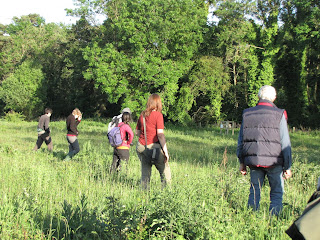News headlines on my Twitter timeline shout hysterical warnings of rain, as if to douse Sunday's air disaster fireball. It's not something we get much of round here so I keep going into the porch to admire it. Mmm,
proper rain, I say to myself every time we have a heavy shower.
Alarmist updates say the death-plane pilot is local and flies in the region regularly. The very same aircraft was due to display at two upcoming air shows in Cambridgeshire. I live beneath the flight path of the Imperial War Museum Duxford's air shows, one of the most popular attractions in the UK. I admit I've always been fairly thrilled as the Red Arrows buzz the roads and rooftops, soar and draw red, white and blue hearts in the sky. But the shows are noisy and filthy, and you have to give the traffic jams a wide berth. I prefer to watch birds.
'Beware the Spanish plume' we were warned: heatwave, tornado, thunderstorms. On the evening of Saturday, which was luridly hot, I cycled to my nearest RSPB nature reserve. I wanted to cherish the dwindling summer and stay out watching wildlife in a quiet place until dark.
Entering Fowlmere nature reserve always seems to have a Narnia effect; another world instantly opens up. Still on my bike wearing hi-vis gear, I spot a muntjac deer on the wooded track along the eastern edge. I freeze. These are common animals we're quite used to seeing, but I'm in reverential mode. The muntjac freezes too. It peers, stretching its nostrils closer in my direction, a little to the left, a little to the right. I shift a fraction; it twitches. It dips and cocks its head, nodding its indecision to step forward. Then braves a 1-step 2-step 'What's the time Mr Wolf'' approach. Still not quite deciding what it sees, the animal barks five times, plaintively, as if calling its mum. Now it relaxes, turning its burnished brown bottom on me to graze awhile, then shows its white scut like an insult and plunges out of sight.
Kingfisher Hide: Two women. I sigh. I want to be alone. 'There's a kingfisher over there if you're interested' says one of them generously, before leaving me to it. Soon it flies straight towards me as if to land right in front of me on a strategically placed perch before choosing an awkward angle in a hawthorn bush.
 |
| Photo by Jo Sinclair |
After ten minutes of trying to photograph an orange and electric-blue blur swaying gently in the breeze, a family of four from Royston arrives. The boys are excited. They've been before. Their mum says she visits about four times a week. She tells me someone saw otters here at about 8 one evening. 'Go to the Reedbed Hide' she suggests. 'The marsh harriers will be getting ready for bed - in the tree on the right. You can see the sun catch their plumage at this time of night.'
At the hide the marsh harriers are flying above the mere. The water is crowded with forty nervous ducks and a hundred geese. They're moulting, 'in eclipse'. The mere has a circular scum of down. Two harriers screech and squabble; one is holding something - maybe prey - in its feet. Co-joined briefly in an eight foot wingspan of raptor they twist, flap, plummet and roll. A man laughs in astonishment and admiration. 'Couldn't ask for a better view!'.
Even when there's not all this action a bird hide is a rewarding place to be. You can simply sit and stare and breathe deeply, happy as a fisherman to be whiling away the time listening to the wind in the reeds.
One of the harriers goes down. For a drink? To roost? I can't see, but the waterfowl seem unperturbed. Three turtle doves fly in. Thirsty birds after such a hot day. They're so nervy one tries to take a sip mid-air. I can see a snipe, cautious at the edge of the reeds, and a lapwing announces its arrival with its kazoo peewit call.
A turtle dove is purring when I leave. The barn owl box looks empty. Flocks of crows rise, flap and settle in dead trees. I go through the woods, along the clean chalky trout stream. I divert into a meadow where I see fallow deer. They step out of the trees and their hides seem to describe the crepuscular light: there's a white hart, spotted does, two chocolate brown forms, several fawns.
There are rabbits, a hare and two muntjac on the stubble field when I leave the reserve. I see a bat by the light of my bicycle lamps. I hope it might follow the insects I disturb. I pass a combine harvester working a field in a blaze of lights bright as a factory. Into the dark again and I hear a large animal double back from the road. Further on I detect a black, vague shape ahead and luckily brake in time. A fallow deer, about a day dead, lies on the path. Its leg is right-angled and its staring head rests upon a dark stain. I reach a pub at last orders and dine beneath a floodlit ash tree, and note that there are surprisingly few moths.































